Montmartre - Moulin Rouge
Paris, from Montmartre to the Place Blanche
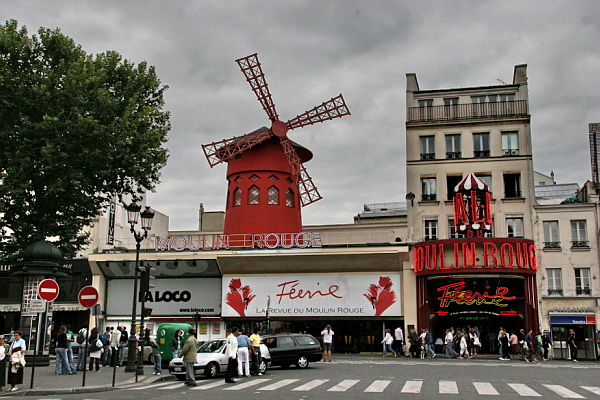
Such a' Belle Epoque'

Carefree life, Flickleness and Joie de Vivre... Those are the three words that could best sum up this unique period in the History of France. It was a rest between two wars, a period of transition between two centuries, during which the social barriers collapsed, when the industrial revolution gave hope of a better life for all, in a rich cultural profusion and that promised much fun.
The middle-class mixed with the riffraff, the popular culture was enchanced in a contented disorder full of joy and vitality. In that atmosphere, which favoured artistic creativity, literary circles appeared and disappeared according to people'meetings, while painters and drawers got especially inspired by this joyful sometimes outrageous but full of fancy atmosphere that broke completely with the rigid classicism of that period.
The Japonism (a term employed for the first time by the art critic Philippe Burty in 1872 to define a new artistic movement inspired by objects and art from Japan, that had been first shown in 1867 at the Universal Exhibition of Paris), a movement of Far-East inspiration using influences from the Japanese style in French Art, was at its height. Toulouse-Lautrec and his famous Japanese engravings was one of the most famous disciples of that time. The atmosphere fitted perfectly to the appearance of the first cabarets, such as the Moulin Rouge in 1889.
Times of the 7th Art
Concerning architecture, Gustave Eiffel, a real genius of iron architecture, now began his most spectacular project : a 300 metre high tower that could be admired from anywhere in Paris. This was to be the main attraction of the Universal Exhibition of 1889.
Another event of major importance during those years was the first cinematographic screening. On the 28th December 1895, in the Indian lounge of the Grand Cafe, Boulevard des Capucines, in Paris, 23 guests attended an extraordinary show by the Lumiere Brothers.
The photograph that had just been projected onto a small screen had come to life ! Coaches, horses and passers-by started to move, a real-life of a street appeared on the screen : 'At this sight, we stood open-mouthed, completely overawed', said the conjurer Georges Melies, who became famous later by making more than 500 movies full of fantasy and poetry, such as the remarkable Voyage dans la Lune (Journey to the Moon) in 1902.
At the following Exhibition, in 1900, it was Hector Guimard who found fame. In the ever-changing expression of Art Nouveau, he gave a new style to the entrances of the Parisian subway, the Metropolitan, never seen before. Blanche station was the first to see the decorative arabesques and leaf-like curves, which blended with amazing energy and vivacity.
The Butte Montmartre, the bastion of all pleasures
In the midst of this effervescence, the Butte-Montmartre figures as a place of symbolic meaning. In 1891, the Basilica Notre-Dame du Sacre-Coeur was inaugurated with great pomp. It was hoped that, with the basilica on the hilltop, a little prestige would be brought back to the ill frequented hill. But against all expectations, the coexistence of this Holy place and its more nefarious slopes only gave more character to this Mecca of Parisian life. Eccentrics, artists and performers continued going to cabarets, music-halls and cafes in larger numbers, whereas middle-classes, aristocrats and socialites growing more and more attracted to night pleasures, began going there too. Cafe-concerts became the true symbol of this social and cultural melting-pot. Workers, artists, middle-classes and aristocrats gathered at the same table, in a joyful atmosphere of feast and frivolity.
Among these cabarets, some have become famous : the Chat Noir with its rich settings created by Caran d'Ache, the Mirliton, the Folies-Bergeres, the Moulin Rouge... Here, the public came to listen to the anti-conformist songs of Aristide Bruand, the champion of eccentrics, prostitutes, unemployed, and of all those low life people that artists had long despised.
Here, literary groups such as Les Hydropathes, founded by the Bohemian Emile Goudeau or Les Incoherents with their lust for satyric political discussions, were prosperous and highly respected.
Here again, painters found their inspiration, such as Toulouse-Lautrec, a regularl customer in the quarter, who came to immortalise the strange colourful scenes that are midway between frenetic entertainment and the tragic life of the lower-classes, in famous paintings such as Le Chat Noir and La Goulue.
"Les memes coins abritent les memes gens. Sous les colonnes rouges, les solives peintes, dans ce decor de palais barbare, roulent les memes types, danseurs et danseuses lies ventre a ventre dans la communion du rythme, mecs et graines de mecs, combinards, vendeurs de neige ou de tuyaux, marchands de viande ou de plaisir, artistes, flaneurs, michetons, lames de fond que n'absorbe pas la grande houle humaine des etrangers curieux. A cet element male s'enlace l'element femelle, putains, demi-filles, bourgeoises, lesbiennes, et brasseuses d'affaires. Tout se mele, se fond et se confond dans le lent tourbillon qui, de la piste, gagne les pourtours et les promenoirs."
Henry-Jacques. Moulin Rouge - 1925
The most famous cabaret in the world opens its doors
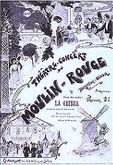 |
At the time of the cafe-concert...the Geisha |
On the 6th October, at the foot of Butte Montmartre, the atmosphere was pretty festive: a new music-hall was opening in the Jardin de Paris, the Moulin Rouge, and it wasn't going unnoticed.
The public came in mass to Place Blanche, to discover this extravagant place with its huge dance floor, mirrors everywhere, and galleries that were the last word in elegance, to mix with the riffraff and girls of easy virtue, in a garden decorated with a big elephant with rides on donkeys for the ladies'pleasure. There was such a wild atmosphere that the show was not only on the stage but all around : aristocrats and louts in caps had fun side by side, in an atmosphere of total euphoria.
The masters of the place were Joseph Oller and Charles Zidler. They nicknamed their establishment Le Premier Palais des Femmes (the first Women Palace) and bet on their success, enthusiastically claiming to whoever listened that the Moulin Rouge would become a temple of music and dance. On the very first day, their hopes were fulfilled, the other music-halls just had to learn !!!
"Vingt jambes en l'air. La pesanteur est envoyee par-dessus les moulins. En lames successives, les femmes s'ecartelent sur la piste, offrant leur sexe aux forces obscures de la terre. Quand elles rebondissent, c'est pour retrouver les ailes perdues. Ainsi, disputees entre deux elements, les danseuses miment la lutte du corps et de l'esprit."
Henri-Jacques. Moulin Rouge - 1925
The French cancan painted by Toulouse-Lautrec
The divine "unruly girls"
 |
La Goulue by Henri de Toulouse-Lautrec 1891 |
The balls at the Moulin Rouge quickly became highly prized events.
For the grand finale, the public discovered, with overwhelming enthusiasm, a new dance, the French Cancan with its dancers, the Chahuteuses (the unruly girls), and its boisterous rhythm, which, to the great displeasure of some people, really made heads turn !!! In the Guide to Paris nightlife, edition 1898, the French Cancan dancers are described as an army of young girls in Paris who dance this divine hullabaloo the way its fame demands it... with such an elasticity when they launch their legs upwards that we are allowed to presume that they are at least as flexible with morals...
Amongst these figureheads of Parisian life, some will go down in history, like the famous La Goulue, immortalised by Toulouse-Lautrec.
"Oui, la Goulue, elle etait celebre. Je lui ai parle, sur les quais du metro. Je l'ai reconnue et je lui ai demande de l'embrasser : "Vous permettez que je vous embrasse, ?" C'etait tres dans le genre. Un personnage du siecle. Elle etait, pour moi, sans age, grande, forte, tres tres grande, dans mes souvenirs. Elle aurait peut-etre 125 ans aujourd'hui ? A Neuilly, il y avait un lion en cage qu'elle domptait... Arletty quoted by Michel Souvais. Les Cancans de la Goulue
The Quadrille, a prelude to the French Cancan
In 1850, Celeste Mogador, a leading dancer at the Bal Mabille - which later on became the Mabille Orchestra of the Moulin Rouge - invented a new dance, the Quadrille : eight breathtaking minutes in perfect hamony with Offenbach as undisputed master of music.
A boisterous rhythm, balance, flexibility, on the verge of acrobacy... and the Quadrille girls in their titillating costume turned the heads of the high society of Paris.
Le Quadrille, plus en chair, vaut surtout par la tradition qu'il offre, chaque jour, a ceux, hommes de tous les mondes, qui ont garde la representation d'un Moulin, asile du cancan, des jupes envolees, des corps renverses pour mieux s'offrir, des refrains carres encadres de puissants trombones et de cornets a pistons, derniere figure d'un symbole qui a quitte Paris depuis longtemps pour faire son tour du monde..."Furia francese".
Henri-Jacques. Moulin Rouge - 1925
From London to Paris, the debuts of the French Cancan
It was in 1861, in London, when Charles Morton, a great master of the music-hall who was inspired by the Quadrille, invented the French Cancan. The word Cancan referred to the particularly noisy characteristic of this new dance. Whereas British people were rather shocked by this dance on the edge of indecency, in Paris the popularity of the Cancan was still growing. It was being shaped progressively, until it became a ritualised dance, exclusively for women, whose main art consisted of doing the splitts and uncovering lacy underskirts.
Black stockings, garters and frills dressed girls of at least 1,70m tall, who spun in contentment in a series of gracious 'pizzicatti', before the eyes of bewitched clients of the Moulin Rouge.
"Elle etait jeune et belle
Port'Saint-Martin Grenelle
Elle avait l'?il mutin
Grenell'Port'Saint-Martin."
Duo song, by Yvette Guilbert and La Goulue
The Great Ladies of the French Cancan
 |
La Goulue's start |
Under colourful and rather roguish stage names, the most famous dancers of that time competed on the stage of the Moulin Rouge, each one with her own temperament. The undisputed figurehead of the French Cancan is still today the famous Goulue, with her inimitable cheeky humour. But she was not the only one who won fame thanks to the Cancan : there were Jane Avril also known as Jeanne la Folle (crazy Jane), La Mome Fromage named so since she was so young, Grille d'Egout (gutter grate), who was well-known for her taste for uproar, Nini Pattes-en-l'Air ('legs in the air') who would open a French Cancan school, and Yvette Guilbert, a famous national fortune-teller who imitated Sarah Bernhardt...
The only notorious male character among the flowing rows of girls was Valentin le Desosse (the 'boneless') also called L'Homme du Quadrille (the Quadrille man), who will never be bettered in the way he had of making the girls dance...
Toulouse-Lautrec, one of the more regular clients, was the great witness of this splendid period. Among his paintings, seventeen are directly inspired by the Moulin Rouge, and many are famous world-wide. They represent emblematic characters. Undoubtlessly, Toulouse-Lautrec would not have become who he was without the Moulin Rouge and La Goulue. On the other hand, would the music-hall have become what it is today without the talented painter ?
"Aujourd'hui, ce n'est pas un jour ordinaire. Je tiens a remercier tous les controleurs, tout le personnel, patrons et employes, et surtout toutes ces femmes qui ont couru apres moi pendant de si longues annees."
Valentin le Desosse
Great moments of the moulin rouge, early in the century
 |
The Petomane |
The first ten years of the Moulin Rouge led, from one to another in a whirlpool of, ever more extravagant nights. It was inspired by the circus, whose attractions were shown at the cabaret - such as that of the Petomane (the 'farting' man), who went down in history...
In addition to the French Cancan, the first real revues are performed: e.g. the revue Circassiens et Circassiennes, in 1890. Every night, people come for the 10 p.m concerts; the Quat'zarts ball and its procession; a nude Cleopatra carried by four men and surrounded by nude girls who lay, languid, on flower beds...
A beginning trumpeted that lost some of its pomp by the new century. On the 26 December 1902, the last ball occurred in general indifference. The Quadrille was no longer fashionable, the ball of the Moulin Rouge became a concert-theatre under the leadership of M. Paul-Louis Flers, a well-known revue-director in Paris who wanted to turn the Moulin Rouge into a more prestigious place. He has run the famous establishment for... 9 months.
Many managers came after him; that will not keep the Moulin Rouge from regaining its former popularity.
"...un fait d'une gravite extreme et d'une inadmissible impudeur..."
General society of protest against public licentiousness.
1893 (refering to the Bal des Quat'zarts)
The Great Moments of Music-Hall
Operettas and Spectacular revues

Untill the beginning of World War I, the Moulin Rouge has become a true temple dedicated to operetta.
There again, the music of Offenbach used to accompany successive shows in lightness, contentment and joy : the public was present for dreaming, laughing, crying and feel emotions at the sight of 'Voluptata', 'La Feuille de Vigne', 'Le Reve d'Egypte', 'Tais-toi tu m'affoles'... and many other revues with titles each time more evocative.
The Automotive fair (yes !) on the 7th December 1904, many people from upper-classes gathered, who sang, danced and regretted the end of a so delightful night. Whereas in 1907, the charming novice Mistinguett, makes her debuts on the stage of the Moulin Rouge in 'La Revue de la Femme'. That was only the beginning of the long story. Quickly, her exceptionnal talent blasted in public : as she imitates the langourous jig of Max Dearly, she was the instigator of the famous Valse Chaloupee (swaying waltz) and then became a shining Star in the Music-Hall's firmament.
"Je vous jure que ce n'est pas commode d'en trouver des "comme il faut", ni trop grandes, ni trop petites, ni trop grosses, ni trop laides... ni trop jolies..."
Mistinguett, speaking about her Girls.
The Mistinguett's years
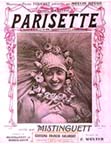 |
Score sung by Misstinguett |
After World War I, Francis Salabert ran the Moulin Rouge. Since he was more of a businessman than a showman, he employed Pierre Foucret to hold the purse strings and left Jacques-Charles - the No. 1 revue-director of that time - the assignment of brightening up the "Great Revue". He dreamt of setting-up a show with american dancing-girls. After much discussion, he succeeded in convincing Gertrude Hoffmann, then director of the Hoffmann ballet, to join him, and they started to create the revue 'New York- Montmartre'.
At the top of the bill were the Dolly Sisters, Rosy and Jenny, the first twin sisters in the history of music-hall. The 'Broadway style' made a big impact when it entered the Parisian scene...
On the night of the first show, Mistinguett, then known as the Queen of Music-Hall, was in the audience. She understood at once that a true revolution was happening...
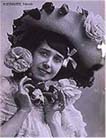 |
Misstinguett |
Jacques-Charles and Mistinguett had a stormy but very profitable relationship. Very close to each other in life and inspired co-workers on the stage, their story was punctuated with quarrels and make-ups, with disputes and reconciliations... A turbulent passion that gave birth to legendary creations : the "Revue Mistinguett" in 1925, the famous 'Ca c'est Paris' in 1926 and many others. Great Nights with the Miss and her Girls, animated the Parisian nights until 1929, when the two main characters retired from the stage.
Meanwhile, the French Cancan, which had regained prestige, was turning the public's head in the Ballroom, in the lower ground floor of the Moulin Rouge. A certain Gesmar, only 20 years old, became a master in costume making. His drawings and models, which displayed pure and breathtaking beauty, remained associated with the Moulin Rouge's image.
During that time, a young man named Gabin was making his debut on stage as the quintessential 'badboy' in Paris...
"Le directeur du Moulin Rouge a du recruter une brigade de detectives pour interdire l'acces du theatre aux curieux. Ce ne sont partout qu'amoncellements de dentelles, de fleurs, de fourrures, de plumes, de satins et de perles. Les coulisses du Moulin ressemblent a un conte des Mille et une nuits."
Advertising statement 7th November 1925
The end of Golden Age
After Mistinguett's departure, nothing would ever be the same in the world of music-hall...
The 7th Art - as French people call the cinema - overwhelmed the 'Great Revues' and the ballroom became an ultra modern night-club.. however, the Moulin Rouge still had some great moments : the acclaimed Cotton Club, which had had great success in New York, the nights with Ray Ventura and his Collegiens... some unforgettable moments before the dark years to come.
1939-1945 : Paris did not have much fun under the German's heel. The only ray of sunshine, a few days before the Liberation of Paris, was Edith Piaf, whose talent was becoming renowned, image who sang on the stage of the Moulin Rouge. In the first part of her show, a young man with a kind of "Cow Boy" was scheduled... Yves Montand. She later said about him : 'this guy who behaves as if he was in the plains of the Far West is nothing but a singer from Marseille... the height of vulgarity !.'
He said in return that she was a merchant of depression. Exchange of kind words... but the Great Lady was not long to understand the potential of this lanky boy, who needed just a little help to change his appearance... Later on, he admitted then she had made him save time.
The Revnal
The stars are back
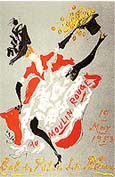 |
The Bal des Petits Lits Blancs |
It was six years after World War II before the Moulin Rouge recovered its former magnificence.
On the 22nd of June 1951, Georges France, alias Jo France, the founder of Balajo, bought the Bal du Moulin Rouge and set about renovating in order to allow the famous establishment to hold again the most wonderful nights in Paris, and regain its splendour of long-ago. (The settings imagined by Jo France and painted for the most by Henri Mahe still ravish the Moulin Rouge visitors.)
Dance parties, entertainments and receptions for charity were back... among them, the 25th Bal des Petits Lits Blancs (for hospitalized children), on the 19th May 1963 was a red letter day : some 1200 artists and stars came from every corner of the world to honour Guy des Cars, the organizer of that night. "
"Mais quand je passe devant le Moulin Rouge, redevenu jeune sous les memes traits que son aine, je pense qu'il accomplit sa tache intelligemment et gaiement. D'autres souvenirs naissent dans son reflet pourpre, d'autres noms, d'autres visages, d'autres images. Et, dans quelques annees, d'autres ecrivains celebreront le Moulin Rouge, toujours vif..."
Pierre Mac Orlan - 1951
I dreamt of the top of the bill
 |
Line Renaud-poster designed by Van Caulaert |
In 1955, Joseph and Louis Clerico became managers of the establishment and were eager to continue the great tradition of the 'Bal Populaire'. They joined together with Jean Bauchet, a child of the theatre, to accompany this 'old and respectable lady', still lively, into the modern times.
A small revolution occured in the palace : a kitchen was fitted. The 'dinner-show' of the Moulin Rouge became one of the most sought Parisian attractions. As the public really enjoyed this new option, the establishment's fame spread abroad. From every corner of the world, people came to see the Moulin Rouge, as one of the great monuments of the most beautiful capital in the world...
 |
Bourvil-poster designed by Jean Bastia |
Both newcomers full of promise and prestigious stars were top of the bill : Charles Trenet, Charles Aznavour, Line Renaud, Bourvil, Roger Pierre and Jean-Marc Thibault, Fernand Raynaud... All of them expressed their talent on the most famous stage in France.
Elvis Presley himself never came to Paris without spending a little time at the Moulin Rouge. It is said that he had a crush on a French Cancan dancer. The famous quadrille, then under the leadership of the demanding Doris Haug, kept winning over people's hearts.
"Moi, j'aime le Music-Hall..."
Charles Trenet
F for Formidable
 |
 |
 |
In 1962, Jacki Clerico, the son of Joseph Clercio, took-over the succession as head of the most famous cabaret in the world. The Moulin Rouge had taken back its legendary place.
The sanctuary of Place Blanche, famous for its long history, came back once again with flair. Two years after his arrival at the Moulin Rouge, Jacki Clerico embarked on a new adventure : the construction of a giant aquarium where nude dancers moved about like delightful mermaids in front of dumfounded spectators...
He selected only names beginning with an F for his revues : then due to superstition, nowadays it remains a tradition.
Frou Frou, Frisson, Fascination, Fantastic, Frenesie... each one succeeded the others, until the unforgettable Formidable, the revue of the Centenary, for which the public is still enthusiastic today. Crowned heads, international bigwigs, stars of show biz... all of this high society met up on Place Blanche on the 12th February 1988, to celebrate the 100 year anniversary of this venerable institution dedicated to feast and pleasure... wishing it a long and joyful life.